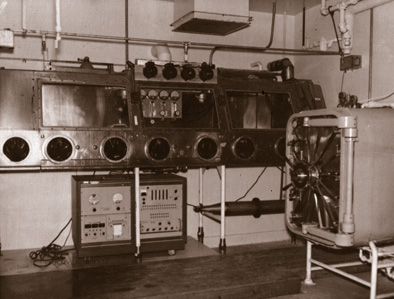- Homepage >
- Organization >
- History >
- 1963-1972
History 1963-1972
The late 1960s and 1970s were a difficult time at DPG. As a result of Department of Defense 112 (a project initiated by the Secretary of Defense to investigate the condition of the Chemical/Biological program), the US stepped up its program of conducting chemical and biological weapons tests outside the continental US. One program resulting from DOD 112 was "Project Deseret", which authorized an agency to "plan and conduct large scale chemical and biological tests outside the United States in order to provide a variety of environmental backgrounds". In 1968, the Army consolidated DPG and the Deseret Chemical Depot once again, this time under the Deseret Test Center. The Deseret Test Center was an important part of "Project Deseret" and as a result of the overseas testing activity, the DPG facility experienced dramatic reductions in budget, force, and morale. During this period the mission of the facility was:

- To provide and operate a CBR proving ground for the Army; plan and conduct or participate in the testing of CBR munitions, agents and other materiel as directed by the US Army Test and Evaluation Command
- Plan and conduct field and laboratory tests and investigations in chemical, biological, radiological, meteorological, and ecological and epidemiological areas to ensure "responsible" technological and safety systems and materiel
- Plan, monitor, and participate in service tests as directed by the Army Test and Evaluation Command
Although the primary mission was CBR testing, the facility continued to provide other research and engineering tests. These additional tests included: armored equipment, air defense systems, airborne aviation equipment, rockets and missiles, atomic demolition munitions, communications and data processing equipment for signal and meteorological equipment, protective and defense systems and techniques, ammunition, mines, grenades and other munitions.
From 1974 to 1976, the Army Materiel Acquisition Review Committee recommended DPG for closure. Economical and logistical arguments were made in favor of keeping the base open. Perhaps most convincing, however, was the fact that the Army had not been successful at locating an alternative location to carry out the work of DPG which would be politically, financially, and logistically tenable. It was stated, "The mission [of DPG] is politically acceptable in Utah. It would be politically unacceptable at the national and international level [to move to any] alternative site". Alternative uses of DPG were studied as options to help stimulate additional activity at the base that would allow it to remain open. In the early 1970s, the National Aeronautics and Space Administration (NASA) announced its interest in finding alternatives to the Kennedy Space Center in Florida as the main headquarters for the space shuttle program. Utah businessmen and politicians promoted DPG as a candidate for a shuttle launch and recovery site and it became one of the sites on the list of possible alternative locations.
During the 1970s, binary weapons, which were created during the 1950s, represented the largest part of the "non-routine" testing at DPG (Smith, 1989). Binary weapons were a considerable advance in CW and BW, as they made it safer to handle and transport the weapons. Other tests at DPG included obscurants and a great variety of testing for other federal agencies.
For a more detailed look at the history of Dugway Proving Ground, see the links below.
HISTORY  1800-1942
1800-1942  1942-1945
1942-1945  1945-1950
1945-1950  1950-1963
1950-1963  1963-1972
1963-1972  1972-1989
1972-1989
